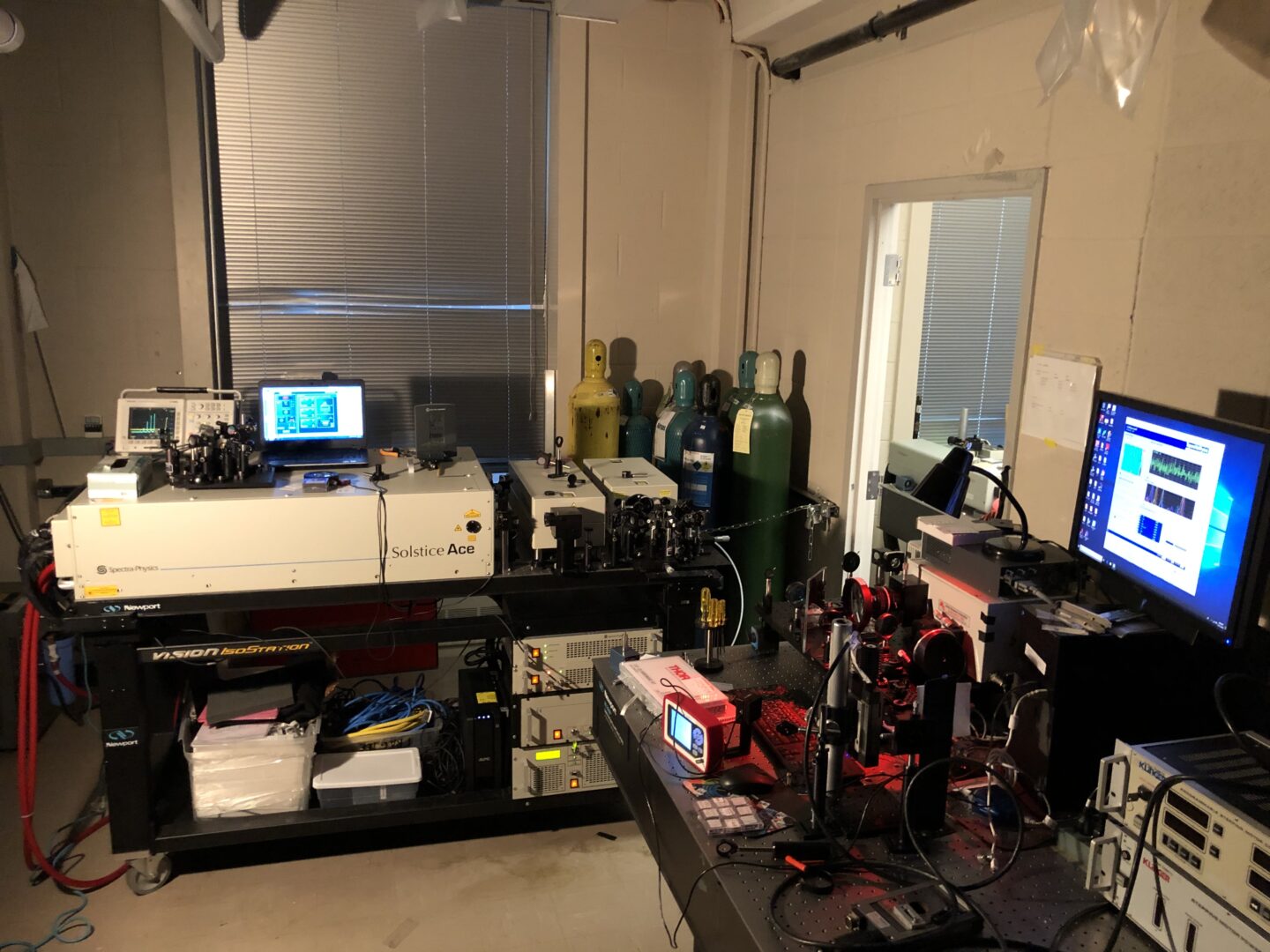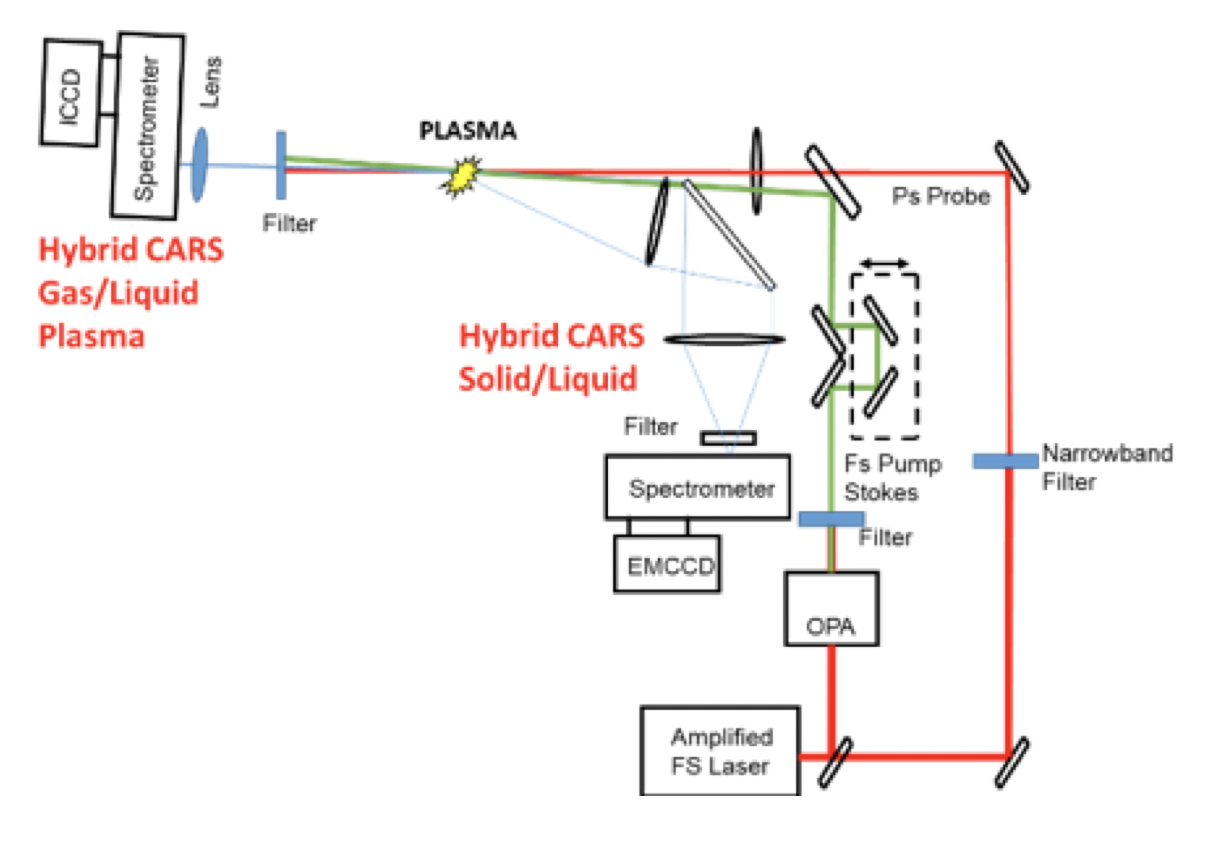Hybrid Coherent Anti-Stokes Raman Scattering
Advanced Diagnostics Navigation
- Atomic and molecular species, positive and negative ions
- Laser-Induced Fluorescence (LIF) and Two-Photon Absorption LIF (TALIF)
- Radar Resonant Enhanced Multi-Photon Ionization (Radar REMPI)
- Characterization of plasma, chemical composition and dynamic behavior
- Electron velocity distribution function, gas flow velocity and temperature
- Electric field and space potential
- Nanoparticle Diagnostics
- Surface Diagnostics
Hybrid Coherent Anti-Stokes Raman Scattering (Hybrid CARS)

CARS has been proven to be a very useful spectroscopic tool for measuring Raman rotational and vibrational spectra. The fs/ps hybrid CARS diagnostic developed at Princeton [1,2] allows for in-situ single shot coherent Raman spectroscopy at kHz rate. The laser source is a Spectra Physics Solstice Ace equipped with an Optical Parametric Amplifier, delivering 1 mJ of 100 fs pulses at 1 kHz in the 1400-1800 nm NIR region for the pump and Stokes beams. The probe beam is obtained by spectrally filtering the 800 nm fundamental. The CARS signal is recorded by a Princeton Instruments imaging spectrometer equipped with a Hamamatsu C9100 cooled EMCCD camera for trace detection, or with an intensified PCO DIMAX HD fast camera for temperature measurements at 1 kHz. This hybrid technique combines the robustness of frequency-resolved CARS with the advantages of time-resolved CARS spectroscopy. Using this hybrid technique, we have demonstrated real-time standoff detection of molecular species based on their vibrational spectra, with high sensitivity and selectivity [3-5]. We can utilize this powerful diagnostic for measuring concentration of negative ions in the low-temperature gaseous plasma and spectroscopically investigate the nanoparticle dynamics. From our trace detection limit using CARS to measure sub-ng of targets in real-time [5], we estimate to be able to collect the coherent Raman spectra from C60 at densities less than 1011 cm-3. Furthermore, the hybrid CARS setup allows for real-time non-equilibrium temperature measurements in gases and plasmas by simultaneously recording the rotational and vibrational spectra in a single shot with kHz repetition rate. Our diagnostic has the capability of single-shot non-equilibrium temperature measurements with 1kHz rate at densities below 1 Torr [6,7]. This allows for measurement of minor species down to 0.1% of an atmospheric pressure mixture. Additionally, using the LINE-CARS approach [2,5] to record 1-D images in a single shot, we can also spatially resolve mixtures of gases.

- D. Pestov et al., Science 316, 265 (2007).
- A. Dogariu, patent US9163988 (2015).
- A. Dogariu, A. Goltsov, D. Pestov, A. V. Sokolov, and M. Scully, J. Appl. Phys. 103, 036103 (2008).
- A. Dogariu, A. Goltsov, and M. O. Scully, J. Biomed. Opt. 13, 54004 (2008).
- A. Dogariu and A. Pidwerbetsky, Proc. SPIE 8358-27, (2012).
- A. Dogariu, L. E. Dogariu, M. S. Smith, J. Lafferty, and R. B. Miles, AIAA SciTech 2019 Forum, 1089 (2019).
- A. Dogariu, L. Dogariu, M. Smith, B. McManamen, J. Lafferty, and R. Miles, “Velocity and Temperature Measurements in Mach 18 Nitrogen Flow at Tunnel 9,” AIAA SciTech 2021 Forum, 0020 (2021).
 This capability is located at the Princeton University Dept. of Mechanical and Aerospace Engineering.
This capability is located at the Princeton University Dept. of Mechanical and Aerospace Engineering.
